The voice on the radio (Animal Department Director, Sherry Samuels) said that there was a cluster of strange, red, tube-like fungi growing out of the ground next to the Lemur House and wondered if I knew what it was.
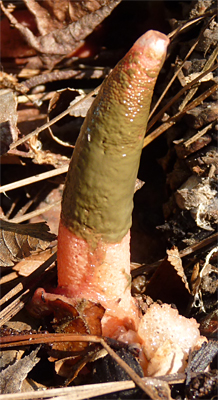
I said that I didn’t know what it was but would stop by and have a look at them later.
It was a few days before I finally made it to the site and, after having a look at the horn-shaped growths and agreeing that they were obviously some sort of fungus, I still didn’t know exactly what they were.
Some of them were “wilted” and laying on the ground while others appeared fresh, if fungus can be termed as being fresh.
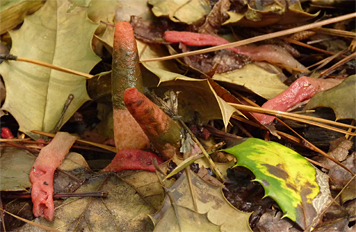
I happen to have an identification guide to mushrooms and after a quick browse through the many photos in the book I was able to come up with a match, Elegant Stinkhorn (Mutinus elegans).
The visible “horns” of this stinkhorn are the spore bearing stems. Just below the leaf litter are “eggs” from which the stems “hatch.”
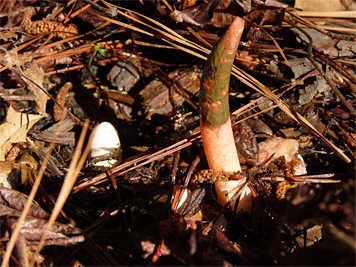
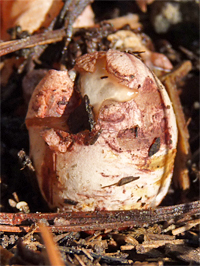
The eggs, according to my mushroom guide’s author, are edible, “…but not recommended.” I don’t think that I’ll be tempted to try them regardless.
Case closed.
There’s nothing like a good mystery to start off the week!
Six days after the case of the stinkhorns, I came across a more typical member of that strange group of organisms (not animal, not plant) growing under a dogwood near the entrance to the Dinosaur Trail.
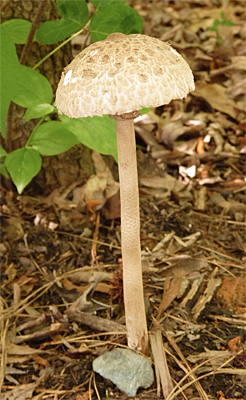
I’m not certain about the identity of this mushroom, but think that it’s a Parasol Mushroom (Lepiota procera). The height, scaling on the cap, and season (June-October) as well as other features seem right for the species, but I’m not positive. My guide says that in regard to the identity of Parasol Mushrooms “smell is important and should be noted” but it doesn’t say exactly what that smell should be, only that it’s “slight, not distinctive.” I guess you have to be a connoisseur of mushrooms to understand what that means.
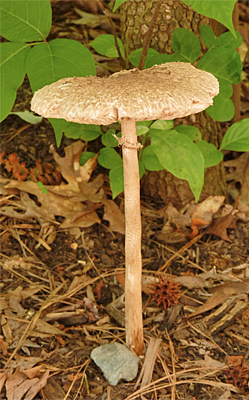
I’m not recommending this or any other mushroom be consumed, but according to my guide, Parasol Mushrooms are rated as “excellent” for edibility with a “sweet” in the taste category. Again, I’m not going to eat one of these mushrooms and don’t recommend that you do either, just quoting my guide.
The guide that I used for the identifications of the stinkhorn and parasol (if that’s what it is) is Mushrooms of North America, by Roger Phillips. It’s a large format book and not really suited for work in the field (it won’t fit into your pocket), but it has over a thousand photos and extensive descriptions of the many mushrooms included within its pages.
Happy hunting.
Found some in my front yard today. Did not know what they were. Thank you for the information!
Mutinus elegans and Mutinus caninus are very similar judging by photos found on internet. I took this photo yesterday – http://www.imagereserve.com/photo/20180922145239 and identified it as Mutinus elegans, but I’m not completely sure, it may be Mutinus caninus. Any ideas?
I found a strange long pink thing growing in my yard today when I was out with my dogs. After reading this I am thinking it is the stinkhorn.
Have a Stinkhorn in my yard so glad to find this site to inform me about the Stinkhorn. Thank you!
Glad to have helped.
Thanks,
I have SMALL orange-red mushrooms in very moist area..just wondering what they are?
If you have a photo of the mushrooms please send them to greed@ncmls.org and I’ll try an ID them for you.
Thanks,
i found a stinkhorn in my yard, i was wondering how can I get rid of it?
You could leave it be and it will eventually go away. Or, you could take a shovel and turn over the dirt where it’s growing. Turn over the dirt several times until the stinkhorn is completely chopped into small pieces, diced.
Thanks,
I RECENTLY SAW THE “STINK HORN” GROWING IN A RATHER SUNNY PLACE GLAD SOME ONE HAS GIVEN IT A NAME. FEW PEOPLE JUST LAUGHED WHEN i TRIED TO DESCRIBE IT. MINE APPEARED TO BE WET AND IT WAS A DRY AREA. ALSO HAVE LOTS OF EARTH STAR MUSHROOMS around .
Good, I’m glad you were able to figure out the identity of the stinkhorn.
They will laugh no more! Well, maybe.
Thanks,
is the Tubular Red Fungas toxic to dogs if they come in contact wioth it or eat one? How do I get ried of them?
I could find no reference stating that this fungus is toxic to dogs. In fact, most references say that it is not toxic and is of little concern to dog owners who worry that their dog will eat the stinkhorns and become ill.
The fungus with wither, dry up and disappear on its own. It you want to hurry the process and dig it up, go ahead, make sure you get the “eggs” beneath the surface.
Good luck!!
I just found a couple of their “eggs” behind the duck yard. They’ve been sitting on my desk the last couple of days waiting for you to come back to work. It started to “hatch” this morning. I remembered you did a post about odd looking smelly red fungus and now I don’t need to save the juicy smelly red things for you to ID. Thanks Greg!
Always a pleasure.
Thanks,
Thank you!! I found a stinkhorn in my back yard and was totally mystified… my son found your blog or I would still be wondering.
Good, good, glad you found us.
Thanks,
I also want to thank you. I found a group of four of these mushrooms in my front yard flower bed and was mustified! I Googled tubulat mushroom and “whaaLaa!” your photos and explanations came up. Must also mention that there is a very heavy mucklike smell that is almost sickening to these mushrooms. Maybe that is where they got their name:Stinkhorn. Dennis Dotson
Thanks for the comments Dennis.
And yes, the smell is the reason for the stinkhorn part of its name.
Eureka! I just discovered one of these today along our driveway. Strangely, it’s not a very moist environment, barring the fact that we’ve had a really wet spring. Our stinkhorn was brilliant orange, just like a carrot and there were several bottle flies crawling on it. I snapped a couple photos before it was ultimately destroyed by some construction activity. Thanks so much! I searched “strange tubular fungus” and here you were!!
Good, glad you were able to figure it out.
One of our Rangers (Erin) here at the Museum found one last week as well. There was one above ground and another about to “hatch,” but unfortunately, I think it was trampled on. It was right next to one of the trails here with heavy traffic.
Have a good one,
Thanks for figuring this out for me and sharing it with everyone Greg.
You’re welcome, Sherry. Thanks for pointing them out to me!
How fascinating! And elegant!
Thanks Erin.
It is indeed fascinating…all of the little mysteries of nature that are out there waiting to be discovered.